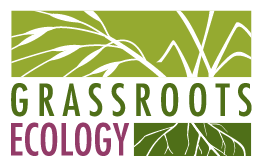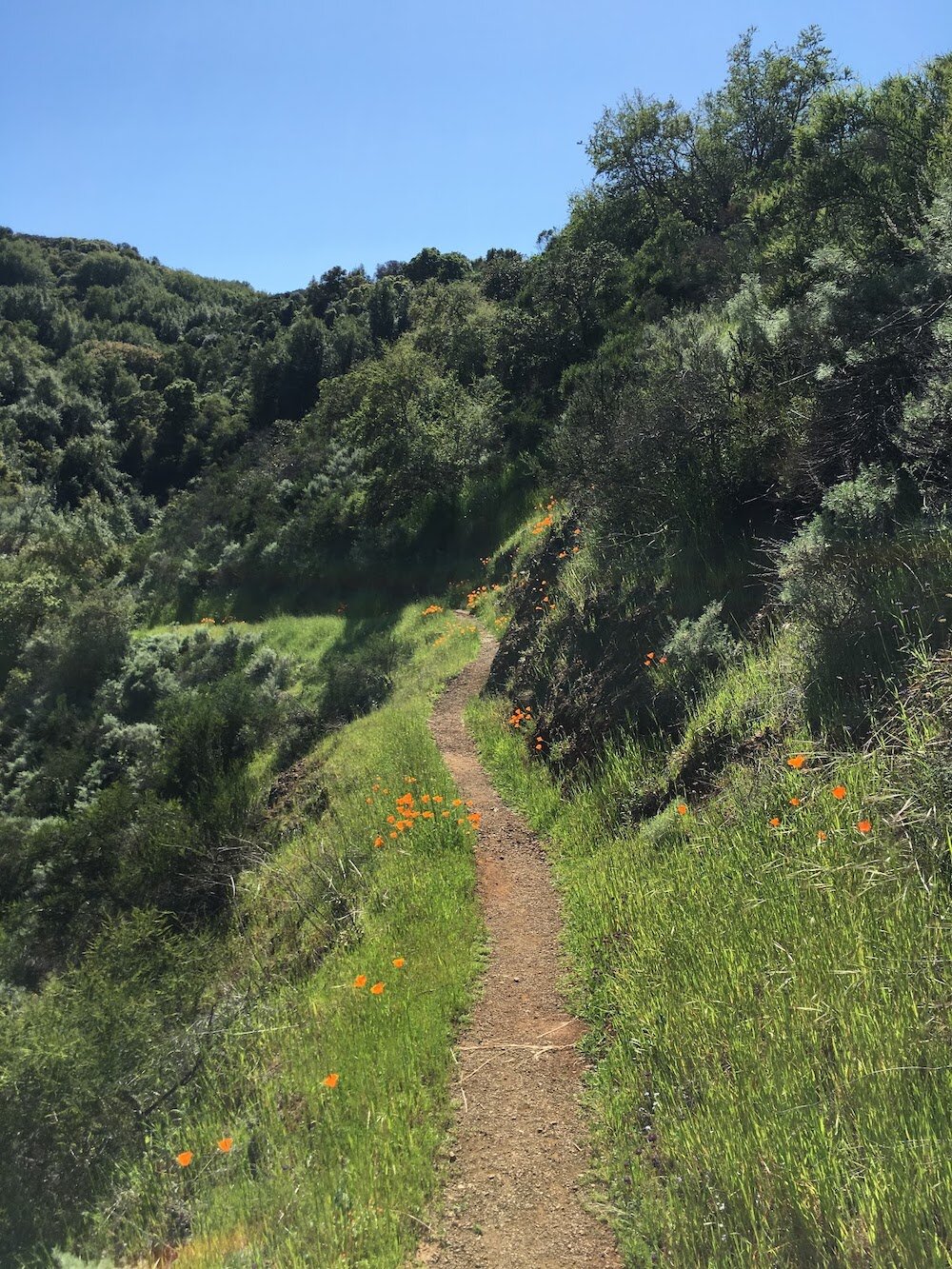7 Things We Love about Foothills Nature Preserve
By Claire Grist, Project Lead, and Nina Orellana, Restoration Specialist
Foothills restoration team members Claire and Nina with a blooming chaparral currant on Vista Hill
One of the bright spots of 2020 for us was the historic opening of Foothills Nature Preserve to the public (previously called Foothills Park). Since the 1,400 acre preserve’s initial opening in 1965, access was restricted to residents of Palo Alto—until now. As of December 17, this restriction was lifted and the preserve is now open for all to enjoy.
Since Grassroots Ecology has gotten to know the preserve well over the past seven years through our habitat restoration efforts, we are excited to share with you our Top 7 List of what makes Foothills Nature Preserve so special— helping you all get ready to enjoy and be stewards of this amazing community space.
1. Trails Galore!
The preserve has a trail system totaling 15 miles and spanning varied terrain and levels of difficulty, so there is something for hikers of all experience levels. Trails take you through the preserve’s diverse ecosystems, including oak woodland, creeks, and chaparral, and to some fantastic viewpoints. Explore all of the trails at Foothills with the preserve map.
A great hike to start with is the Coyote Trail to Chamise Trail loop. This trail starts at the bottom of Las Trampas Valley and takes you up through a mixed bay laurel and oak woodland to Vista Hill, where you can rest and gaze out to the sweeping views of the Bay Area. Then you can take the Chamise Trail back down to Las Trampas Valley, where we frequently find wild turkeys or deer grazing.
2. Abundant Wildlife
Something neat about Foothills Nature Preserve is that it is just one puzzle piece in a swath of preserves that link all the way up to the ridgetop of the Santa Cruz Mountains and over towards the Pacific Ocean, making this a great place for wildlife to live and pass through.
Our most common sightings in the preserve are deer and turkeys in the early mornings browsing on the lawns. There is a red-tailed hawk that makes Las Trampas Valley its home and it can often be seen hunting voles on the lawn too!
If you are lucky, you may catch a glimpse of some of the less commonly seen critters that live within the Preserve. This past year alone we saw a bobcat hunting near the Interpretive Center, rough skinned newts swimming in Buckeye Creek, tarantulas in search of a mate up at Vista Hill, a long-tailed weasel dodging between plants in one of our restoration areas, and a barn owl swoop over our Native Plant Nursery. Other not as often seen animal species known to utilize the preserve include the mountain lion, grey fox, badger, skunk, coyote, and the threatened dusky-footed woodrat.
A long-tailed weasel spotted on the Foothills lawn
3. Picnic Areas and Accessible Nature
Foothills Nature Preserve has a handful of easily accessible picnic areas and spaces to enjoy nature with friends and family.
The Orchard Glen picnic area is the ideal place for a family gathering, with nearby parking and bathrooms. The picnic tables are in the shade of beautiful mature trees, adjacent to a large sunny lawn that is perfect for playing games, whether it be frisbee, capture the flag, or duck duck goose.
The bench outside of the Interpretive Center is a favorite spot to catch up with a friend while soaking in sunshine and valley floor views and spotting birds and other wildlife.
4. Habitat for Rare and Endemic Species
Western leatherwood (Dirca occidentalis), a rare and endemic species to the Bay Area
Foothills Nature Preserve boasts a variety of plant communities, some of which are home to rare and endangered species.
Western leatherwood (Dirca occidentalis) is a rare and endemic plant to the Bay Area. This means it is only found in this region—nowhere else in the entire world! Foothills Nature Preserve is lucky to have a thriving population of this deciduous shrub hiding amongst its shady hills. During late winter you might spot its bright yellow blooms along the trail, which emerge before its leaves. Be careful not to disturb this fragile plant or its surrounding ecosystem.
Blue oak (Quercus douglasii) is endemic to California where it grows in the foothills of the Bay area. The name derives from the dark blue-green tint of its leaves, which are deciduous. There is an impressive stand of this oak on the western side of the preserve, on the sunny slopes above and below Los Trancos trail. Blue oaks are beautiful but very slow growing, only adding a few inches every year. While it is not classified as a threatened species, the blue oak is at risk to climate change impacts, as it is particularly adapted to thrive in the Mediterranean climate of California. Our stand of blue oaks at Foothills Nature Preserve is also threatened by French broom, an aggressive invasive weed, which we are working to remove.
5. Breathtaking Views
One of the first things you’ll see when entering the preserve is Boronda Lake with a view of Windy Hill in the background. In the early morning, mist rises from the lake as coots gracefully glide along the surface. Swimming is not allowed in the lake, but canoeing is, and there are two docks that take you out onto the water.
Vista Hill is one of the most popular places in the preserve, and rightfully so. From Vista Hill you can see all of Silicon Valley and the San Francisco Bay. On a clear day you can see north past San Francisco to Mount Tamalpais, and east to the Diablo Range where you might glimpse a snow capped Mount Hamilton on a cold winter morning.
Project Lead Claire overlooking the Bay through the branches of a madrone
6. Native Plant Nursery
Foothills Nature Preserve is the home of our Native Plant Nursery! Grassroots Ecology has been growing locally-genetic native plants for Bay Area habitat restoration projects since the 90’s, and our Native Plant Nursery moved to Foothills Park in 2005. Follow the road past the Oak Grove picnic area to peek in at the baby plants and learn more about the benefits of local species. If you are interested in supporting native pollinators in your own yard, visit our Nursery Sales page.
7. A Long History of Land Stewardship
Since the opening of Foothills Park nearly half a century ago, thousands of people have dedicated their time to preserving and protecting the park’s habitat. The Friends of Foothills Park have spent decades removing invasive plants and making park improvements, and continue to convene a committed crew of volunteers on Sunday mornings. Since 2013, Grassroots Ecology has partnered with the City of Palo Alto to help protect and restore native biodiversity at Foothills alongside the Palo Alto Rangers and the Friends of Foothills Park. With the help of thousands of Grassroots Ecology volunteers including students, families, corporate groups, and civic organizations, we have installed native plants around the Interpretive Center, converted a swath of the valley lawn to native meadow that is buzzing with bird and insect life, restored native plants to creek areas, and dramatically reduced invasive weeds so that native biodiversity can return to the landscape.
Our Foothills high school Youth Stewards caring for native planting areas
Of course, the history of land stewardship here started millenia before Foothills became a park. The human history of the San Francisco Bay Area goes back at least 10,000 years, when Indigenous Californians moved freely between the changing shores of the bay, and the streams and valleys of the foothills and mountains. Since about 3,000 years ago, the Ramaytush Ohlone lived here in the foothills, hunting, gathering the fruits and nuts of native plants, and acting as stewards of the land, actively tending the animal and plant populations on which they relied. Much of what colonists first described seeing in this area was in fact shaped by Indigenous Peoples who cared for the land through burning, tilling, sowing, and pruning. Indigenous Californians continue to carry out their legacy of land stewardship in the present day and into the future, and we are humbled to join this legacy of caring for the land. We encourage you to research the native land you are visiting or live on, and support your local Indigenous organization.
Before You Go
We’re so excited that this special preserve is now open for all to enjoy and explore! Since the preserve belongs to everyone, we must work together to minimize any negative human impacts to the land and wildlife that comes with increased park usage. Our four top suggestions for responsible recreation at Foothills Nature Preserve are:
Poppies line the trails at Foothills
If you can’t find a garbage can for your trash, pack it out with you. This is true for food scraps and biodegradable waste too! There is no toilet paper fairy, so do not leave toilet paper on the ground. It does not go away.
Stay on marked trails and roads to prevent hillside erosion and protect sensitive habitat areas.
Protect the wildlife (and yourself!) by driving slowly, giving animals their distance, and staying on trails.
Dogs are permitted on-leash on weekdays only. Please do not leave behind dog poop, bagged or otherwise, because there isn’t a dog poop bag fairy either!
If you want to learn about more ways to protect and enjoy the natural world, check out the Leave No Trace website.
We are excited to share more about our experiences at Foothills Nature Preserve with you! Foothill Nature Preserve Ranger Angie Richman will be joining us on Thursday, January 28, 2021 for a virtual Naturalist Talk. Claire will lead the discussion in English at 6pm and Nina will lead in Spanish starting at 7pm. Sign up information for both events can be found on our Naturalist Talks page.
Sources:
Anderson, Kat. Tending the Wild: Native American Knowledge and the Management of California's Natural Resources. Berkeley: University of California Press, 2005.






